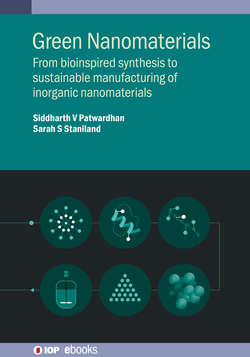Читать книгу Green Nanomaterials - Siddharth Patwardhan - Страница 31
На сайте Литреса книга снята с продажи.
2.4.2.3 Nanoelectronics/spintronics
ОглавлениеAs electronically powered technology has now become vital to our lives, we need more and more efficient methods of transferring electrical energy. Furthermore, the reduction of the size of electronic technology needs consideration. In macroscale electronics electrical energy is transferred by electrons in a metal wire moving through the lattice to form a current; charge difference can build up between two points which have a potential difference between them, which is the voltage. Electronic components have been developed throughout the 20th century, such as capacitors (collecting charge, then releasing it when a critical level is reached), diodes (semiconductors that act as a valve, allowing the electrons to flow easily in one direction but not the other), and transistors (semiconductors that are able to amplify or switch electronic flow), which have allowed our lives to be transformed with ever more complex and ingenious electronic circuity in common everyday devices. However, as size reduces, so too do the physical properties of the material. As wires get thinner, the resistance in the wire vastly increases. As we miniaturise, it may be time to consider whether the movement of the charged electron, i.e. controlling electrical devices by conveying electron charge flowing in a wire, is actually the best method in smaller devices.
Spintronics is a new field of physics studying how the spin of electronics could be a better way to convey and control electronic signal in smaller electronic devices. Apart from the obvious benefit of miniaturisation, this has many advantages. In spintronics, there are additional characteristics of spin, and how the electron spin couples with the atomic orbital (spin–orbit coupling), how electrons can tunnel, and ultimately how these respond to an external magnetic field (figure 2.10(Ci)). All of these can be tuned, offering multiple electronic manipulation methods at the atomic level [43]. As recently as 2010 and 2013, graphite-like structured 2D semiconductor MoS2 was shown to have photoluminescent and transistor behaviour, respectively. Building monolayered layered structures of such semiconductors, insulated and ferromagnetic materials are paving the way for complex spintronic effects that could be used in the nanoelectronics devices of the future. A 2D layered structure of MoS2 on graphene combines the strong spin–orbit coupling of MoS2 with the enhanced spin transport properties of graphene to form a spin field-effect switch capable of both transporting and controlling spin current (figure 2.10(Cii)). Such switches could be used to improve search engines and pattern recognition circuitry capability in the future [39]. However, spintronics is already in technology now: read heads on magnetic hard drives already use the effect of electron tunnelling from ferromagnetic layers through an insulating layer in the material. Combining the set-up of semiconductor RAM devices with magnetic domains for the data storage (instead of electronic charge) and utilising the electronic tunnelling of spintronics has led to the development of magnetoresistive random-access memory (MRAM), which has been heralded to out-compete all other forms of data storage in the future (currently not for high density, but for speed and longevity of retention) [44]. A MRAM is made up of an array of magnetic tunnel junction that holds a bit of information. Each magnetic tunnel junction is composed of a complex layered structure of two ferromagnetically orientated thin films separated by an insulating layer, with the bottom ferromagnetic film ‘pinned’ in orientation by a further antiferromagnetic thin film below.
The key issue with the development of all the complex nanodevice technologies described above is fabrication. Producing the correct material, of the correct phase and orientation in the correct layered or nanoscale morphological structures at the nanoscale is very problematic. Adding to that the ever-increasing need to fabricate such intricate complex materials and systems in a reproducible and sustainable way, for them to be industrially viable for applications, presents a formidable challenge.
